This is the default narration at loading ...
Contents here



Nourishment
Time to fill up the bodies for another exciting excursion into Rome's past.


Colosseum
This magnificent and awestriking amphitheatre was constructed between the years of 72 AD and 80 AD.
It was originally called the Flavian Amphitheatre and was commissioned by Emperor Vespasian and completed under the subsequent Emperor Titus.
The name 'Flavian' is the family name of both of these two emperors.
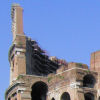

Colosseum
Roman amphitheatres were normally placed in the outskirts of the city but Colosseum was erected in the very heart of Rome on the site where the unpopular emperor Nero following Rome's great fire in 64 AD had confiscated valuable land and built his pompous residence
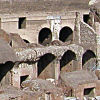

Colosseum
The colosseum could seat around 50,000 spectators.
The best seats at the north and south ends were reserved for the emperor and the Vestal Virgins, respectively.
At the same level around the theatre were the seats for the senators. Knights and non-senatorial nobles occupied the next level up followed further up by the common people, the lower seats of which were taken by the richer commoners.
The top level was reserved for the poorest, slaves and women.


Colosseum
Special booth section reserved for the emperor and his family.


Colosseum
The theatre was divided in separate sections vertically and each row was numbered as was each seat. In this way, each individual seat could be exactly identified and crowd control made easier by using sectional entrances and exists.
The same principles are used in today's stadions and theatres.


Colosseum
Internal paths ran all along the inner level of the theatre to ease movement.
Most likely, however, one could not freely walk around the entire theatre since many sections were reserved for special groups such as tutors with their students.
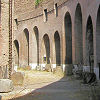

Colosseum
Circular paths also ran all along the outer level of the theatre at different levels so as to allow passage without disturbing the spectators in their seats.


Colosseum
The oval arena measured 83 meters and 48 meters on the long and short axis, respectively.
The floor was made of wood, which was covered by sand.
The most popular shows were gladiator fights, which were sponsored by private families.
Also animal hunts were popular; a large variety of exotic animals and wild beasts. To improve realism, trees and bushes would be planted on the floor to simulate a natural environment and thus add to the danger and excitement.
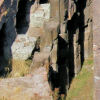

Colosseum
The arena floor covered a huge and elaborate network of underground passages and cages in two levels.
The gladiators and animals were held here until their turn. Some 80-90 vertical shafts allowed for the gladiators and animals to appear on the scene in strategic locations of the arena.
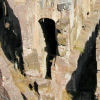

Colosseum
The gladiators and animals were led into the underground cages through a network of tunnels, which originated in many of the buildings surrounding Colosseum.
Some tunnels were specially constructed to allow the emperor and the Vestal Virgins to reach and exit their dedicated booths without having to mingle with the general crowd.
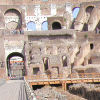

Colosseum
Ancient writers maintain that the arena occasionally would be filled with water in order to stage naval battle scenes.
It would not have been a problem to provide the water nor creating a pool, but the arena size and shallowness would have made it difficult to use normal marine vessels with any effectiveness.
The wooden bridge running through the center of the arena is a modern construction.


Colosseum
The perimeter wall stands 48 meters high.
The facade consists on three levels of arcades, each of which is framed by engaged columns: Doric, Ionic and Corinthian, from bottom to top. An attic is superimposed on top of the arcade levels.
The second- and third level arcades originally contained a sculpture, presumably of divinities.


Colosseum
The lower level had a total of 80 arches, each uniquely marked so as to allow quick entry and exit. Spectators were provided with a pottery shard denoting the entry/exit arcade, the level, row and seat number.
The wall has suffered severe damage over the centuries from earthquakes and fires. Also, much of the original masonry and marble has been pilfered and used for other constructions, e.g., St. Peter's basilica.
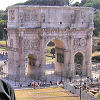

Arch of Constantine
Rome has many arches, which were constructed to celebrate a triumph or as a memorial. The Arch of Constantine was erected close to Colosseum and inaugurated in 315 AD, some 250 years after the construction of Colosseum.
Emperor Constantine had the arch built to celebrate his military victories.
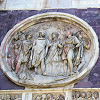

Arch of Constantine
Interestingly, few of the many decorations on the arch carry any traces of the emperor, nor depictions of his life, deeds or religion.
Instead, many of the friezes show events from the life of emperor Marcus Aurelius (161 AD - 180 AD)! Why? Because the Imperial artists lazily 'recycled' fragments from earlier periods rather than creating new ones!